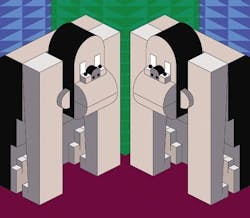Above the stepladder hung a banana. The chimps first walked quietly through the room. Then, suddenly, one of them saw the banana. He ran toward the stepladder and tried to climb it, but others joined him and tried to catch the banana as well. They were screaming and showing their teeth. As soon as one of them got on the top of the ladder and reached for the banana, the researchers sprayed water on the whole group using a fire hose.After that, they removed one chimp and put another one into the group. When this new chimp saw the banana, he enthusiastically climbed the stepladder and others followed him. Again, when one of them tried to reach the banana, the whole group got sprayed with water.They repeated this until the animals understood that trying to get the banana definitely meant getting wet. From that moment, every time a new monkey entered the group and tried to climb the ladder, the others pulled him from the stairs, shouting and screaming out loud. In the end, none of the chimps left in the group had ever experienced that reaching for the banana meant getting wet, yet when a new chimp ran to the stepladder, the group pulled him down, although none of them knew why! I work for a systems integrator company. Our professionals are sometimes called by recruiters, and unfortunately, some of them have actually left the company. With their leaving, the company is also losing important knowledge and experience.In the DNAHow can we avoid losing this expertise? We should embed best practices within the DNA of our company, thus making the enterprise less dependent on the individual skills and expertise of the employees.With this in mind, we decided to establish a competence centre that develops guidelines, templates and training courses, thus enabling colleagues to deliver high quality products and services. When people leave the company and their places are taken by others, the new ones quickly learn which pitfalls to avoid. We more or less tell them “not to reach for the banana.”But what about our clients? Can the Manufacturing Execution Systems (MES) that we implement help them to preserve knowledge and skills? Well, of course they can. For example, the application could check to see that operators follows assembly instructions in the right order. And it can help employees to correctly and completely register the actual production process.But note that as long as a manufacturing enterprise is working in an artisanal way, it is not ready to use an MES. As long as the quality of the end product largely depends on the individual skills of the workers, then the company’s maturity level is too low. Only when departments have agreed upon optimum procedures—e.g. by describing instructions on paper or by standardizing reports in Excel—and when the organization checks to ensure that these procedures are followed, can the organization automate them.I’ve seen this go wrong in some companies. Their manufacturing information technology department had delivered an information system that worked well on a technical level. Nevertheless, the users were not able to configure it successfully because they did not agree on the way that things are done in their company. They’d skipped the maturity level of describing optimum procedures. In other words, they didn’t know yet that they’d better not touch the banana.Bianca Scholten, [email protected], is a Principal at IT integration firm TASK24, in The Netherlands, and a voting member of the SP95 committee of the International Society of Automation. Her book, “The Road to Integration; a Guide to Applying the ISA95 Standard in Manufacturing,” is available at www.ISA.org.
About the Author
Sign up for our eNewsletters
Get the latest news and updates

Leaders relevant to this article:
